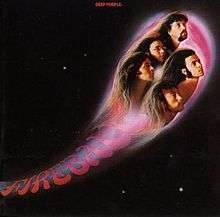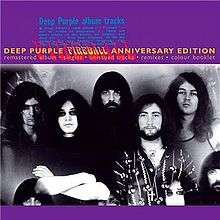Fireball (album)
| Fireball | ||||
|---|---|---|---|---|
 | ||||
| Studio album by Deep Purple | ||||
| Released | July 1971 (US and Canada), 15 September 1971 (UK and Europe) | |||
| Recorded | at De Lane Lea Studios and Olympic Studios in London, & The Hermitage, Welcombe, North Devon from September 1970 to June 1971[1] | |||
| Genre | Hard rock, heavy metal | |||
| Length | 40:30 | |||
| Label |
Harvest Records (UK) Warner Bros. (US) | |||
| Producer | Deep Purple | |||
| Deep Purple chronology | ||||
| ||||
| Alternative cover | ||||
 25th anniversary CD slipcase |
||||
| Singles from Fireball | ||||
|
||||
| Professional ratings | |
|---|---|
| Review scores | |
| Source | Rating |
| Allmusic | |
| Sputnik Music | |
Fireball is the fifth album by English Rock band Deep Purple, released in 1971 and the second with the classic Mk II line-up. It was recorded at various times between September 1970 and June 1971. It became the first of the band's three UK No. 1 albums, though it did not stay on the charts as long as its predecessor, Deep Purple in Rock.
Singles
The original UK version had "Demon's Eye" as its third track, but did not include "Strange Kind of Woman", which was instead released as a single there. It was vice versa on the American and Japanese releases. The boogie-inspired "Strange Kind of Woman" single reached No. 8 in the UK.
"Strange Kind of Woman" has been a staple of the live set up to the present day, and "Fireball" also made a few live appearances, mainly as an encore. "Strange Kind of Woman" and "The Mule" appear on the 1972 live album Made in Japan, with the latter morphing into an Ian Paice drum solo.
"Anyone's Daughter" was played on the 1993–1994 tours, while "Fools", "No One Came", "I'm Alone", "Demon's Eye" and "No No No" have all made periodic appearances in various tours since 1996.
Releases and reissues
The original vinyl release was in a gatefold sleeve, with a generic Harvest LP-bag and a lyric-insert.
In September 2010, a limited edition 24k gold CD was released by Audio Fidelity. The CD was mastered from the original master tapes by Steve Hoffman. The gold CD contained the original USA track listing with "Strange Kind of Woman" and does not have "Demon's Eye".
Members' views on the album
Most of the band does not consider the album a classic, although it is one of Ian Gillan's favourites. He stated in a 1974 interview: "The reason I liked that so much was because I thought, from a writing point of view, it was really the beginning of tremendous possibilities of expression. And some of the tracks on that album are really, really inventive."[4] However, Gillan also said that the inclusion of "Anyone's Daughter" on the album was "A good bit of fun, but a mistake."[5]
Blackmore, in particular, stated publicly that he was not overly pleased with Fireball. He said of the production: "That was a bit of a disaster, because it was thrown together in the studio. Management pressure, we had no time. 'You gotta play here, here, there, then you've got to make an LP.' I told them, 'you want an LP, you've got to give us time.' But they didn't. I just threw ideas to the group that I thought up on the spur of the moment."[4]
Later influences
On 9 April 2011 episode of That Metal Show, guitar virtuoso Yngwie Malmsteen stated that his older sister had given him Fireball when he was eight years old, and "it changed everything" for him. Similarly, Metallica drummer Lars Ulrich stated that he purchased a copy of Fireball within 12 hours after his father had taken him to a 1973 Deep Purple concert in Copenhagen, and he credits the concert and album for sparking his interest in hard rock music.[6]
Likewise, Michael Monroe stated on Eddie Trunk's podcast that it was the first album he ever bought, and one of the first he ever heard along with Led Zeppelin II, and was a major influence to get him into a career in rock and roll.
King Diamond also mentions Fireball as the first studio album he purchased as a teenager and an important influence in his future career.[7]
Track listing
All songs written by Ritchie Blackmore, Ian Gillan, Roger Glover, Jon Lord and Ian Paice.
Original European release
- Side one
| No. | Title | Length |
|---|---|---|
| 1. | "Fireball" | 3:25 |
| 2. | "No No No" | 6:54 |
| 3. | "Demon's Eye" | 5:19 |
| 4. | "Anyone's Daughter" | 4:43 |
- Side two
| No. | Title | Length |
|---|---|---|
| 5. | "The Mule" | 5:23 |
| 6. | "Fools" | 8:21 |
| 7. | "No One Came" | 6:28 |
| 25th Anniversary Edition Bonus Tracks | ||
|---|---|---|
| No. | Title | Length |
| 8. | "Strange Kind of Woman" (a-side remix '96) | 4:07 |
| 9. | "I'm Alone (single b-side)" | 3:08 |
| 10. | "Freedom" (album out-take) | 3:37 |
| 11. | "Slow Train" (album out-take) | 5:38 |
| 12. | "Demon's Eye" (remix '96) | 6:13 |
| 13. | "The Noise Abatement Society Tapes (Midnight in Moscow, Robin Hood, William Tell)" | 4:17 |
| 14. | "Fireball" (take 1 – instrumental) | 4:09 |
| 15. | "Backwards Piano" (Reversed piano solo at the end of "No One Came.") | 0:56 |
| 16. | "No One Came" (remix '96) | 6:24 |
Original US/Canadian/Japanese release
- Side one
| No. | Title | Length |
|---|---|---|
| 1. | "Fireball" | 3:25 |
| 2. | "No No No" | 6:54 |
| 3. | "Strange Kind of Woman" | 4:07 |
| 4. | "Anyone's Daughter" | 4:43 |
- Side two
| No. | Title | Length |
|---|---|---|
| 5. | "The Mule" | 5:23 |
| 6. | "Fools" | 8:21 |
| 7. | "No One Came" | 6:28 |
Personnel
- Deep Purple
- Ritchie Blackmore – lead guitar
- Jon Lord – keyboards, Hammond organ
- Ian Paice – drums
- Ian Gillan – lead vocals
- Roger Glover – bass guitar
- Additional personnel
- Recorded between September 1970 and June 1971 at De Lane Lea Studios, Olympic Studios, and The Hermitage
- Engineered by Martin Birch, Lou Austin and Alan O'Duffy
- Peter Mew – Original album remastering
- Tom Bender – Engineering work on the bonus tracks
Charts
|
|
Certifications
| Region | Certification | Certified units/Sales |
|---|---|---|
| United States (RIAA)[8] | 1× Gold | 500,000^ |
| Netherlands (NVPI)[9] | Gold | 50,000^ |
|
^shipments figures based on certification alone | ||
References
- ↑ http://www.discogs.com/Deep-Purple-Fireball/master/1632
- ↑ Allmusic review
- ↑ http://www.sputnikmusic.com/review/31826/Deep-Purple-Fireball/
- 1 2 Steve Rosen Interviews with Ian Gillan and Ritchie Blackmore, 1974 on YouTube Retrieved from YouTube "Ritchie Blackmore, Guitar God|Part 2/5" on 14 January 2014.
- ↑ Album liner notes in anniversary booklet
- ↑ Grow, Kory. "Read Lars Ulrich's Passionate Deep Purple Rock Hall Induction". rollingstone.com. Retrieved 4 May 2016.
- ↑ King Diamond's official website: http://www.covenworldwide.org/bandhistory02.php
- ↑ "American album certifications – Deep Purple – Fireball". Recording Industry Association of America. If necessary, click Advanced, then click Format, then select Album, then click SEARCH
- ↑ "Dutch album certifications – Deep Purple – Deep Purple in Rock" (in Dutch). Nederlandse Vereniging van Producenten en Importeurs van beeld- en geluidsdragers.
External links
| Preceded by Who's Next by The Who |
UK number one album: Fireball 25 September 1971 – 1 October 1971 |
Succeeded by Every Picture Tells A Story by Rod Stewart |